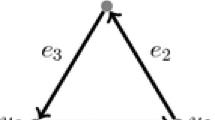Abstract
We study various ideals arising in the theory of system reliability. We use ideas from the theory of divisors, orientations, and matroids on graphs to describe the minimal polyhedral cellular resolutions of these ideals. In each case, we give an explicit combinatorial description of the minimal generating set for each higher syzygy module in terms of the acyclic orientations of the graph, the reduced divisors, and the bounded regions of the graphic hyperplane arrangement. The resolutions of all these ideals are closely related, and their Betti numbers are independent of the characteristic of the base field. We apply these results to compute the reliability of their associated systems.





Similar content being viewed by others
Notes
The Tutte polynomial is defined by \(T(x,y)=\sum _{A\subseteq E}(x-1)^{k(A)-k(E(G))}(y-1)^{k(A)+|A|-|V(G)|}\), where k(A) is the number of connected components of the subgraph on A.
We use the notation \({\mathcal C}_G^s\) in order to be coherent with the notation used in §4; however, in [22], it is denoted by \({\mathcal O}_{{\mathcal {M}}}\), where \({\mathcal {M}}\) is the associated graphic matroid. We let \({\mathcal C}_G^s\), \({\mathcal C}_G\), \({\mathfrak T}_G^s\), and \({\mathfrak T}_G\), respectively, denote the ideals \({\mathcal O}_{{\mathcal H}_G^{s}}\), \(\bar{{\mathcal O}}_{{\mathcal H}_G^{s}}\), \({\mathcal O}_{{\mathcal H}_G^{s}}^\vee \), and \(\bar{{\mathcal O}}_{{\mathcal H}_G^{s}}^\vee \) from §3.1.
Gioan in [14] defines a s-connected orientation as an orientation in which every vertex is reachable from s by a directed path. We use the notation \({\mathfrak T}_k\) and the name oriented k-spanning tree in order to emphasize that \({\mathfrak T}_k\) is an acyclic subgraph of G containing a rooted spanning tree with k extra edges.
References
Agrawal, A., Barlow, R.E.: A survey of network reliability and domination theory. Oper. Res. 32(3), 478–492 (1984)
An, Y., Baker, M., Kuperberg, G., Shokrieh, F.: Canonical representatives for divisor classes on tropical curves and the Matrix-Tree Theorem. Forum Math. Sigma 2, e24 (2014)
Backman, S.: Riemann–Roch theory for graph orientations (2014). Preprint at arXiv:1401.3309
Benson, B., Chakrabarty, D., Tetali, P.: \(G\)-parking functions, acyclic orientations and spanning trees. Discrete Math. 310(8), 1340–1353 (2010)
Bruns, W., Herzog, J.: Cohen–Macaulay rings. Cambridge Studies in Advanced Mathematics, vol. 39. Cambridge University Press, Cambridge (1993)
Bayer, D., Sturmfels, B.: Cellular resolutions of monomial modules. J. Reine Angew. Math. 502, 123–140 (1998)
Baker, M., Shokrieh, F.: Chip-firing games, potential theory on graphs, and spanning trees. J. Comb. Theory Ser. A 120(1), 164–182 (2013)
Cori, R., Rossin, D., Salvy, B.: Polynomial ideals for sandpiles and their Gröbner bases. Theor. Comput. Sci. 276(1–2), 1–15 (2002)
Dhar, D.: Self-organized critical state of sandpile automaton models. Phys. Rev. Lett. 64(14), 1613–1616 (1990)
Dohmen, K.: Improved Bonferroni Inequalities Via Abstract Tubes: Inequalities and Identities of Inclusion-Exclusion Type. Lecture Notes in Mathematics, vol. 1826. Springer, Berlin (2003)
Dochtermann, A., Sanyal, R.: Laplacian ideals, arrangements, and resolutions. J. Algebraic Comb. 40(3), 805–822 (2014)
Eisenbud, D.: The geometry of syzygies, vol. 229 of Graduate Texts in Mathematics. Springer, New York. A second course in commutative algebra and algebraic geometry (2005)
Eagon, J.A., Reiner, V.: Resolutions of Stanley–Reisner rings and Alexander duality. J. Pure Appl. Algebra 130(3), 265–275 (1998)
Gioan, E.: Enumerating degree sequences in digraphs and a cycle–cocycle reversing system. Eur. J. Comb. 28(4), 1351–1366 (2007)
Giglio, B., Wynn, H.P.: Monomial ideals and the Scarf complex for coherent systems in reliability theory. Ann. Stat. 32, 1289–1311 (2004)
Greene, C., Zaslavsky, T.: On the interpretation of Whitney numbers through arrangements of hyperplanes, zonotopes, non-Radon partitions, and orientations of graphs. Trans. Am. Math. Soc. 280(1), 97–126 (1983)
Johnson Jr, Allen, M., Malek, M.: Survey of software tools for evaluating reliability, availability, and serviceability. ACM Comput. Surv. (CSUR) 20(4), 227–269 (1988)
Kateri, M., Mohammadi, F., Sturmfels, B.: A family of quasisymmetry models. J. Algebraic Stat. 6(1), 1–17 (2015)
Levine, L., Propp, J.: What is \(\dots \) a sandpile? Not. Am. Math. Soc. 57(8), 976–979 (2010)
Miller, E., Sturmfels, B.: Combinatorial Commutative Algebra. Graduate Texts in Mathematics, vol. 227. Springer, New York (2005)
Mohammadi, F., Shokrieh, F.: Divisors on graphs, binomial and monomial ideals, and cellular resolutions (2013). Preprint available at arXiv:1306.5351
Novik, I., Postnikov, A., Sturmfels, B.: Syzygies of oriented matroids. Duke Math. J. 111(2), 287–317 (2002)
Naiman, D.Q., Wynn, H.P.: Inclusion-exclusion-Bonferroni identities and inequalities for discrete tube-like problems via Euler characteristics. Ann. Stat. 20, 43–76 (1992)
Satyanarayana, A., Prabhakar, A.: New topological formula and rapid algorithm for reliability analysis of complex networks. IEEE Trans. Reliab. 27(2), 82–100 (1978)
Acknowledgments
The author is very grateful to Bernd Sturmfels and Volkmar Welker for many helpful conversations, and she would like to thank Lionel Levine, Dinh Le Van, and Raman Sanyal for their comments on the first draft. She also thanks Eduardo Sáenz-de-Cabezón and Henry Wynn for introducing her to system reliability theory. The author was supported by the Alexander von Humboldt Foundation.
Author information
Authors and Affiliations
Corresponding author
Rights and permissions
About this article
Cite this article
Mohammadi, F. Divisors on graphs, orientations, syzygies, and system reliability. J Algebr Comb 43, 465–483 (2016). https://doi.org/10.1007/s10801-015-0641-y
Received:
Accepted:
Published:
Issue Date:
DOI: https://doi.org/10.1007/s10801-015-0641-y




